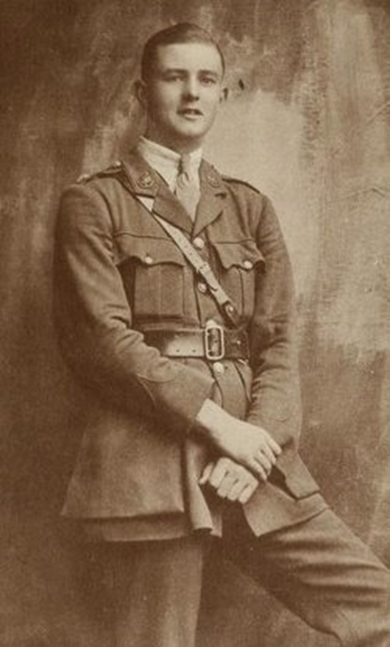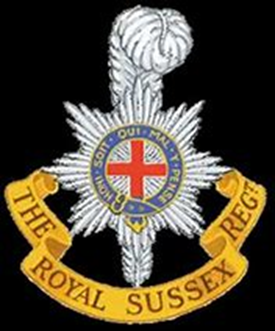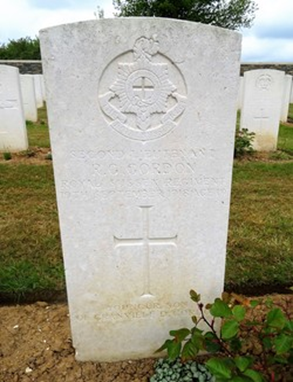RONALD GRANVILLE GORDON
2nd Lieutenant, 3rd Bn. attd. 2nd Bn., Royal Sussex Regiment
Killed in Action, Pontruet, near St. Quentin, Somme, France,
19 September 1918, aged 19.
He is buried at Cerisy-Gailly Military Cemetery, Somme, France.
Plot III. J. 13.

The person in the above photograph is
believed to be Ronald Gordon
(Click to enlarge)
Ronald Granville Gordon was born in 1899 and baptised on 12 March 1899 at Acton Green, Middlesex. His parents were Granville Dempster Gordon, a solicitor, and Louisa Maud Elphinstone Gordon of 6, Bedford Road, London.
In the 1901 census he was living at 6, Bedford Road, Acton. His father Granville was 41 and a solicitor born in Cheshunt, Hertfordshire. His mother Louisa was 38 and was born in London. Ronald lived with his sister Ethel, aged 6, and brother Graham, aged 5. Also listed at 6, Bedford Road were Kate Davies, a 29-year-old cook/domestic, Maud Short, a 21-year-old parlour maid, Elizabeth Clark, a 34-year-old nurse, and Rose Clark, aged 18, also a nurse.
In 1911 Ronald was a scholar living at Shalesbrook, Forest Row. Granville was now 51, Louisa 47, Ethel 16 and a student, and Ronald 12. Graham does not appear in this census return and was recorded elsewhere. Also recorded were Violet Wright, a 25-year-old cook/domestic, Katherine Ovenden, a 21-year-old parlour maid, Elizabeth Clark a 26-year-old house maid, and Maude Wilson, a 17-year-old kitchen maid. Granville and Ethel had been married for seventeen years and had had three children.

Cap badge of the Royal Sussex Regiment
(Click to enlarge)
Ronald Gordon was killed in action on the Western Front at Pontruet, near Saint Quentin, Aisne, France on 19 September 1918. According to the battalion war diaries 2nd Lieutenant Gordon was a Platoon Commander. On 18 September 1918, at 4.30am, battalion soldiers and Australian comrades were at their jumping off position. They were part of a much larger offensive by the 3rd and 4th Armies. The front was about 1,000 yards wide and 400 yards deep. They were supported by guns of the 2nd Trench Mortar Battery. At 5.20am a creeping barrage began 200 yards ahead of the jumping off point. The leading companies closed up under it and advanced. The first objective (the Green Line) was the German trench system 1,000 yards east of the road junction to Vadencourt. The second objective (the Red Line) was to secure the high ground and slopes overlooking Pontruet. Attacks would then be made on enemy positions around Ste.Hélène.
The left front of the attack met little resistance up to the Green Line but the right flank faced strong resistance and were unable to keep up with the creeping barrage. The left flank turned to attack down the enemy trenches with infantry weapons. Despite a "stiff fight" all resistance was overcome and the objective of taking the Green Line was achieved 30 minutes before the attack on the second objective was due to begin.
This attack took off at Zero Hour plus 190 minutes. Many of the enemy tried to escape before the advance but large numbers of them were captured. The second objective was reached on time and was quickly consolidated for defence despite the slopes being continually swept by enemy machine gun fire. These guns were kept under fire by Lewis and Vickers machine guns.
Later two platoons started forward patrols into the valleys and slopes and made good progress but then met strong resistance and an enemy counter-attack which was successfully repulsed. By late evening the Battalion and Australians were advancing to secure a foothold in the sunken road passing through Ste. Hélène. While some companies made good progress others suffered under heavy machine gun fire.
On the morning of the 19th the battalion was relieved by the 1st Northamptonshire Regiment and were moved back to Brigade Headquarters. They had captured 300 prisoners, nine field guns, several mortars and numerous machine guns, rifles and pieces of equipment.
2nd Lieutenant Gordon was one of ten 2nd Lieutenants to take part in the action and he and three of his fellow officers were killed in action. 21 Other Ranks were killed, 123 were wounded and four were recorded as missing.
Immediately after the action letters of congratulation were received from Army, Corps and Brigade Commanders. The Divisional Commander also made a personal visit.

Gravestone of Ronald Gordon in Cerisy-Gailly Military Cemetery.
The inscription reads: "Younger son of Granville D. Gordon".
(Click to enlarge)
Following his death, 2nd Lt. Gordon was initially buried at Ste. Hélène British Cemetery, near Pontruet in the Département de la Somme. This cemetery was developed in September and October 1918 during the capture of the hamlet of Ste. Hélène during the attack on Pontruet. It contained 88 UK soldiers and one airman. His grave was later relocated when Ste. Hélène British Cemetery was consolidated, along with four other small cemeteries in the Somme region, into the larger Cerisy-Gailly Military Cemetery, which lies about 10 kilometres south-west of Albert. This latter cemetery, originally known as the New French Military Cemetery, was begun in February 1917 and was increased after the Armistice with the graves brought in from the smaller Somme battlefields already referred to. The cemetery now contains 745 Commonwealth burials and commemorations of the First World War. 114 of the burials are unidentified and special memorials commemorate five casualties buried at Maricourt and Ste. Hélène whose graves could not be found. The cemetery was designed by Sir Edwin Lutyens.
On the 4 October 1918 Ronald's death was recorded in the Sussex Agricultural Express where he was recorded as the second son of Granville and Louisa Gordon. On 11 October 1918 the Kent and Sussex Courier added that Ronald had been educated at Lexden House, Seaford, Harrow School, and the Royal Military College. It was noted that Ronald had been killed after being on active service for only a few weeks. Ronald was 19.
Out of his surviving effects Ronald Gordon left £11.2s.4d to his mother, £11.2s.2d to his brother Graham and two amounts of £11.2s.2d to his sister Ethel.
His next of kin would also have received the standard memorial Death Plaque, a bronze commemorative plaque given to the next of kin of those who died in the war. It was inscribed "He died for freedom and honour".
The Memorial Book in Holy Trinity Church in Forest Row was signed by his mother, Louisa, formerly of Shalesbrook, Forest Row, but now living at 8, Scroope Terrace, Cambridge.
Kevin Tillett
30 October 2018

